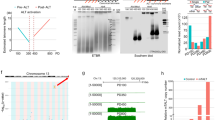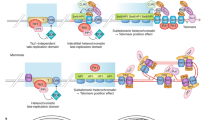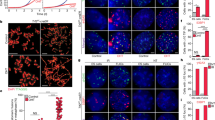Abstract
Here, we describe a role for mammalian DNA methyltransferases (DNMTs) in telomere length control. Mouse embryonic stem (ES) cells genetically deficient for DNMT1, or both DNMT3a and DNMT3b have dramatically elongated telomeres compared with wild-type controls. Mammalian telomere repeats (TTAGGG) lack the canonical CpG methylation site. However, we demonstrate that mouse subtelomeric regions are heavily methylated, and that this modification is decreased in DNMT-deficient cells. We show that other heterochromatic marks, such as histone 3 Lys 9 (H3K9) and histone 4 Lys 20 (H4K20) trimethylation, remain at both subtelomeric and telomeric regions in these cells. Lack of DNMTs also resulted in increased telomeric recombination as indicated by sister-chromatid exchanges involving telomeric sequences, and by the presence of 'alternative lengthening of telomeres' (ALT)-associated promyelocytic leukaemia (PML) bodies (APBs). This increased telomeric recombination may lead to telomere-length changes, although our results do not exclude a potential involvement of telomerase and telomere-binding proteins in the aberrant telomere elongation observed in DNMT-deficient cells. Together, these results demonstrate a previously unappreciated role for DNA methylation in maintaining telomere integrity.
This is a preview of subscription content, access via your institution
Access options
Subscribe to this journal
Receive 12 print issues and online access
$209.00 per year
only $17.42 per issue
Buy this article
- Purchase on Springer Link
- Instant access to full article PDF
Prices may be subject to local taxes which are calculated during checkout





Similar content being viewed by others
References
Blackburn, E. H. Switching and signaling at the telomere. Cell 106, 661–673 (2001).
de Lange, T. Shelterin: the protein complex that shapes and safeguards human telomeres. Genes Dev 19, 2100–2110 (2005).
Collins, K. & Mitchell, J. R. Telomerase in the human organism. Oncogene 21, 564–579 (2002).
Blasco, M. A. Telomeres and human disease: cancer, ageing and beyond. Nature Rev. Genet. 6, 611–622 (2005).
Muntoni, A. & Reddel, R. R. The first molecular details of ALT in human tumor cells. Hum. Mol. Genet. 14, 191–196 (2005).
Dunham, M. A., Neumann, A. A., Fasching, C. L. & Reddel, R. R. Telomere maintenance by recombination in human cells. Nature Genet. 26, 447–450 (2000).
Bechter, O. E., Zou, Y., Walker, W., Wright, W. E. & Shay, J. W. Telomeric recombination in mismatch repair deficient human colon cancer cells and telomerase inhibition. Cancer Res. 64, 3444–3451 (2004).
Bailey, S. M., Brenneman, M. A. & Goodwin, E. H. Frequent recombination in telomeric DNA may extend the proliferative life of telomerase-negative cells. Nucleic Acids Res. 32, 3743–3751 (2004).
Blasco, M. A. Telomere epigenetics: a higher-order control of telomere length in mammalian cells. Carcinogenesis 25, 1083–1087 (2004).
Gonzalo, S. & Blasco, M. A. Role of Rb family in the epigenetic definition of chromatin. Cell Cycle 4, 752–755 (2005).
Garcia-Cao, M., O'Sullivan, R., Peters, A. H., Jenuwein, T. & Blasco, M. A. Epigenetic regulation of telomere length in mammalian cells by the Suv39h1 and Suv39h2 histone methyltransferases. Nature Genet. 36, 94–99 (2004).
García-Cao, M., Gonzalo, S., Dean, D. & Blasco, M. A. Role of the Rb family members in controlling telomere length. Nature Genet. 32, 415–419 (2002).
Gonzalo, S. et al. Role of the RB1 family in stabilizing histone methylation at constitutive heterochromatin. Nature Cell Biol. 7, 420–428 (2005).
Li, E., Beard, C. & Jaenisch, R. Role for DNA methylation in genomic imprinting. Nature 366, 362–365 (1993).
Esteller, M. Relevance of DNA methylation in the management of cancer. Lancet Oncol. 4, 351–358 (2003).
Lehnertz, B. et al. Suv39h-mediated histone H3 lysine 9 methylation directs DNA methylation to major satellite repeats at pericentric heterochromatin. Curr. Biol. 13, 1192–1200 (2003).
Okano, M., Xie, S. & Li, E. Cloning and characterization of a family of novel mammalian DNA (cytosine-5) methyltransferases. Nature Genet. 19, 219–220 (1998).
Okano, M., Bell, D. W., Haber, D. A. & Li, E. DNA methyltransferases Dnmt3a and Dnmt3b are essential for de novo methylation and mammalian development. Cell 99, 247–257 (1999).
Li, E., Bestor, T. H. & Jaenisch, R. Targeted mutation of the DNA methyltransferase gene results in embryonic lethality. Cell 69, 915–926 (1992).
Chen, T., Ueda, Y., Dodge, J. E., Wang, Z. & Li, E. Establishment and maintenance of genomic methylation patterns in mouse embryonic stem cells by Dnmt3a and Dnmt3b. Mol. Cell Biol. 23, 5594–5605 (2003).
Chen, T., Tsujimoto, N. & Li, E. The PWWP domain of Dnmt3a and Dnmt3b is required for directing DNA methylation to the major satellite repeats at pericentric heterochromatin. Mol. Cell Biol. 24, 9048–9058 (2004).
Dodge, J. E. et al. Inactivation of Dnmt3b in mouse embryonic fibroblasts results in DNA hypomethylation, chromosomal instability, and spontaneous immortalization. J. Biol. Chem. 280, 17986–17991 (2005).
Brock, G. J., Charlton, J. & Bird, A. Densely methylated sequences that are preferentially localized at telomere-proximal regions of human chromosomes. Gene 240, 269–277 (1999).
de Lange, T. et al. Structure and variability of human chromosome ends. Mol. Cell Biol. 10, 518–527 (1990).
Steinert, S., Shay, J. W. & Wright, W. E. Modification of subtelomeric DNA. Mol. Cell Biol. 24, 4571–4580 (2004).
Dominguez-Bendala, J. & McWhir, J. Enhanced gene targeting frequency in ES cells with low genomic methylation levels. Transgenic Res. 13, 69–74 (2004).
Maloisel, L. & Rossignol, J. L. Suppression of crossing-over by DNA methylation in Ascobolus. Genes Dev. 12, 1381–1389 (1998).
Bender, J. Cytosine methylation of repeated sequences in eukaryotes: the role of DNA pairing. Trends Biochem. Sci. 23, 252–256 (1998).
Fraga, M. F. et al. Loss of acetylation at Lys16 and trimethylation at Lys20 of histone H4 is a common hallmark of human cancer. Nature Genet. 37, 391–400 (2005).
Samper, E., Goytisolo, F. A., Slijepcevic, P., van Buul, P. P. & Blasco, M. A. Mammalian Ku86 protein prevents telomeric fusions independently of the length of TTAGGG repeats and the G-strand overhang. EMBO Rep. 1, 244–252 (2000).
Zijlmans, M. et al. Telomeres in the mouse have large inter-chromosomal variations in the number of T2AG3 repeats. Proc. Natl Acad. Sci. USA 94, 7423–7428 (1997).
Bailey, S. M. et al. Strand-specific postreplicative processing of mammalian telomeres. Science 293, 2462–2465 (2001).
Fraga, M. F. et al. High-performance capillary electrophoretic method for the quantification of 5-methyl 2′-deoxycytidine in genomic DNA: application to plant, animal and human cancer tissues. Electrophoresis 23, 1677–1681 (2002).
Acknowledgements
S.G. is a Fondo de Investigaciones Sanitarias (FIS) senior scientist. I. J. is a student of the Gulbenkian PhD Program in Biomedicine and is supported by Fundacão para la Ciěncia e Tecnologia/Ministério da Ciěncia e Ensino Superior (FCT/MCT; Portugal). M.E. is funded by the Ministry of Science and Technology of Spain (MCYT; T08-03) and the European Union (CCEE04-00). M.A.B. is funded by the MCYT (SAF2005-00277, GEN2001-4856-C13-08), the regional government of Madrid (GR/SAL/0597/2004), the European Union (TELOSENS FIGH-CT-2002-00217, INTACT LSHC-CT-2003-506803, ZINCAGE FOOD-CT-2003-506850, RISC-RAD FI6R-CT-2003-508842) and the Josef Steiner Cancer Research Award 2003.
Author information
Authors and Affiliations
Corresponding author
Ethics declarations
Competing interests
The authors declare no competing financial interests.
Supplementary information
Supplementary Information
Supplementary Figures S1, S2, S3, Table 1 and Supplementary Text (PDF 673 kb)
Rights and permissions
About this article
Cite this article
Gonzalo, S., Jaco, I., Fraga, M. et al. DNA methyltransferases control telomere length and telomere recombination in mammalian cells. Nat Cell Biol 8, 416–424 (2006). https://doi.org/10.1038/ncb1386
Received:
Accepted:
Published:
Issue Date:
DOI: https://doi.org/10.1038/ncb1386
This article is cited by
-
Chromosome ends and the theory of marginotomy: implications for reproduction
Biogerontology (2024)
-
Reprogramming of fibroblast cells to totipotent state by DNA demethylation
Scientific Reports (2023)
-
Single-cell multi-omics sequencing of human spermatogenesis reveals a DNA demethylation event associated with male meiotic recombination
Nature Cell Biology (2023)
-
Elevated retrotransposon activity and genomic instability in primed pluripotent stem cells
Genome Biology (2021)
-
Telomere length correlates with subtelomeric DNA methylation in long-term mindfulness practitioners
Scientific Reports (2020)



